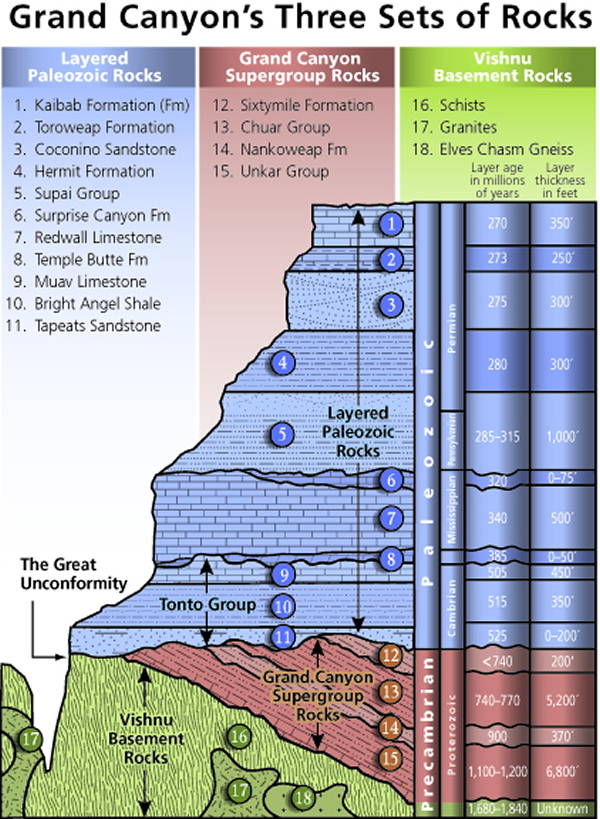
The familiar Cambrian explosion, which started around 540 million years ago, was a game-changer for life on Earth. Bacteria (and archaea) had ruled the planet for over 3 billion years before multi-cellular animals came on the scene. When they did, they diversified rapidly (at least in terms of the span of geologic time). Though we’re right to be impressed by the sudden explosion of life, it’s not the only remarkable thing in that portion of Earth’s history.
There’s a widespread gap in the rock record immediately preceding the Cambrian explosion called the Great Unconformity. The boundary is so prominent—often separating very old igneous and metamorphic rocks from the much younger sedimentary rocks above, as is the case at the base of the Grand Canyon—that all rocks older than this are often lumped together as simply "Precambrian."
Having such a block of time missing just before the rapid Cambrian explosion has made some people suspicious that it might not have been as much of an explosion as it appears. It would be a bit like feeling confused at the climax of a story because you had skipped the setup. A new paper in Nature suggests that far from concealing the story of the Cambrian explosion, the events that created the Great Unconformity may actually explain it.
There are two things that help define the Cambrian explosion. The first is the increase in animal diversity; the second is the rise of biomineralization—the building of shells and skeletons. Those hard parts made the preservation of fossils in the rock record a possibility. That adds to the mystery. Did this newly evolved armor and structure lead to some sort of arms race driving evolution into a higher gear?
It’s not all enigmas and secrets. We know that the composition of seawater changed significantly during this time. The concentration of many of the common ions in seawater—like calcium and sodium—climbed upward. Because high concentrations of calcium can interfere with cellular processes, this has led some to propose that the evolution of calcium carbonate shells was simply a byproduct of the cells' efforts to clear out calcium.
Shanan Peters from the University of Wisconsin and Robert Gaines of Pomona College tie these ideas together by examining the Great Unconformity a little more closely. Using a massive global database of sedimentary rocks together with geochemical records, they thought about what exactly was going on during this mostly missing chapter in Earth’s story.
Since the Great Unconformity is global in extent, we know continents were weathering (eroding away rocks and leaving a gap in recorded time) all around the world. This is what happens when sea level is low—weather and seasons and time break down rocks, and rivers carry sediment out to sea. What’s unusual about the Great Unconformity is how intensive and long-lasting it was.
When sea level rose (and the first Cambrian sediments were laid down on the continents) it swabbed the decks. Nothing erodes quite like the power of waves, so as the shoreline gradually moved inland to higher elevations it washed away the soil and sediment that had built up while rocks broke down. This "wave-base razor," as it’s called, cleared out the material that might have otherwise formed sedimentary rocks, and exposed massive areas of "fresh" bedrock. Between the weathering of these fresh surfaces (which weather very rapidly) and the continued breakdown of all the soil and sediment added to the oceans, concentrations of many ions in the seawater rose quickly.
Support for this idea can also be found in the ratio of strontium isotopes. Strontium-87 mainly makes it into the ocean through the breakdown of continental rocks, whereas strontium-86 comes from mid-ocean ridges. The high point for strontium-87 over the past 900 million years occurred during the Cambrian, suggesting weathering peaked around then. The ratio of neodymium-143 to neodymium-144 (also known as εNd) also helps out by indicating the age of those continental rocks being weathered. Around the time that strontium-87 peaked, εNd hit a low point as continental weathering cut into older and older rocks.
That puts the relationship between the Great Unconformity and the Cambrian explosion in a much different light. The Great Unconformity may not simply be a gap in the record of early evolution of multicellular life with fossilizable hard parts. Instead, the seawater changes caused by the erosion that created the Great Unconformity may have driven the rise of biological calcification.
As was the argument in another paper we covered recently (which shares an author with this one), the rock record is probably telling us more than we’ve given it credit for. As the authors put it, “Although Darwin and other palaeontologists have regarded the resultant widespread hiatus in the rock record as a failure of preservation, the formation of this prominent gap may have actually been an environmental trigger for biomineralization, thereby promoting the Cambrian explosion of marine animals.”
Nature, 2012. DOI: 10.1038/nature10969 (About DOIs).
Listing image by Photograph by www.utcourts.gov
reader comments
19